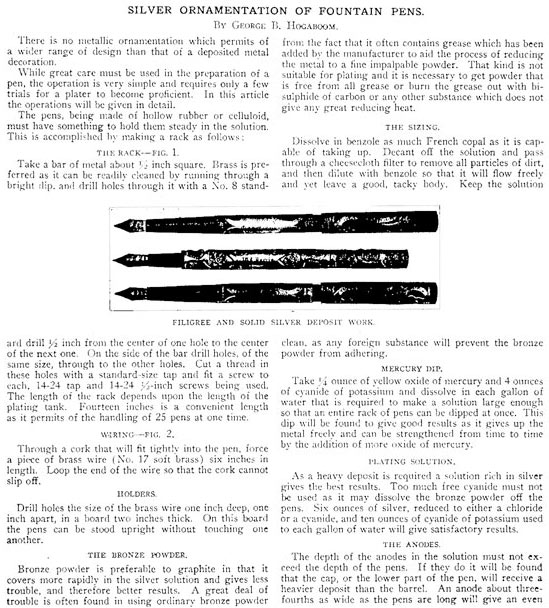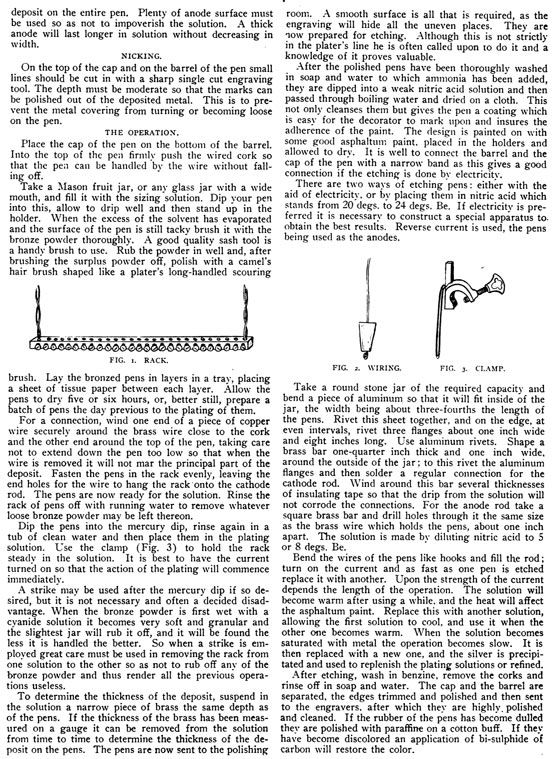|
The 1909 article on electrodeposition of metal overlays (The PENnant, Feb 1994) was a terrific find. As I read it, however, questions began to pop up. Some observations follow. First, it makes perfect sense that the early .999 silver overlays were made by electrodeposition. Pierced-work overlays ("filigree" in pen-speak -- true filigree is wire-work) had been applied to many other objects prior to pens, most notably glass and ceramic vessels. On most of these vessels, the curvature of the surface is so complex as to render impracticable an overlay made from sheet. Electrodeposition, however, makes such work easy: the pattern is either painted on and plated in one step, or the entire object is given a deposit and then the piercing is done by reverse plating or acid etching, the areas to be retained having been covered with asphaltum resist (as described in the 1909 article). There were some disadvantages in applying this technique to pens. Unless the overlay is quite thin, electrolytic and especially chemical piercing can leave a somewhat irregular edge. Furthermore, electrodeposited silver is crystalline, and this can become increasingly apparent with thicker deposits. Thus the characteristic thinness, rough edges, and dull surfaces of the early fine silver pen overlays. Then there was the problem of fine silver itself, the only grade that could practically be deposited. Fine silver (.999) is much softer than sterling (.925), and when thin and crystalline, its vulnerability to both wear and damage is great indeed. And so the pen manufacturers soon switched to overlays fabricated from sheet. Indeed, it seems that, despite the enthusiasm of the 1909 article, electrodeposition never did monopolize overlay production. I can think of all too many early metal pens contemporary with the 1909 article which have broken open along their longitudinal seams, clearly demonstrating their soldered construction. Many of these are low to medium-relief overlays, which seem to have been die-stamped flat and then rolled, soldered, engraved, and, if gold-filled, plated (hence the lack of a visible seam in better gold-filled pens, and the presence of gold at the bottom of even the deepest factory engraving). Still, one may well ask how the higher-relief overlays were made. If stamped, how could the blank be rolled into a tube without crushing the pattern? One method would be to anneal (heat-soften) the blank, fill its hollows from the back with pitch, then roll it between a steel roller inside and rubber rollers outside. Nevertheless, the 1909 article's first illustration, showing a Waterman Patch/Puritan, suggests that electrodeposition could be used as an alternative. I do not know if this pattern is known in fine as opposed to sterling silver; my impression is that it is not. If it were to be made by electrodeposition, however, how might it be done? The 1909 article gives no clue. The answer must be that the overlay was either electroformed -- deposited into a mold -- or deposited over a pattern. The first method would have required less hand-finishing: the mold would have been taken from a master model, and after removal of mold seam marks, the deposited overlay would duplicate it quite exactly. The second method would have been done directly on the pen. The pattern could be built up over the hard rubber using mastic, pitch, glue, or even wax (depending on the temperature of the plating solution), either freehand or with a mold or a roller. Alternatively, the pattern could have been impressed directly into the hard rubber using the same transfer techniques. The disadvantage of the second method, in both of its variants, is that the pattern is weakened as deposition progresses, necessitating touching-up with the graver. It should also be borne in mind that not only silver can be electrodeposited. Copper can be electroformed and then gold-plated, and gold itself can be deposited in various colors and karats. It is time that we reconsidered the widely-held belief that all high-relief overlay work was raised and chased by hand (clearly, in the vast majority of cases, it is too thin to have been cast). The original prices of these pens should remind us that the Golden Age of pens was also the Golden Age of production jewelers, whose labor-saving innovations made quality metalwork unprecedentedly affordable. I suspect that many of the rarest overlays, even semi-custom orders displaying significant variation from example to example, were not executed directly in metal, but rather were carved in a more tractable medium and then electroformed and touched up with gravers. I hope to follow up on this in the near future; living in Providence, long a center for jewelry and plating, should make my research a bit easier. Another line of inquiry would be X-ray examination of high-relief pens, which would disclose telltale seams as well as variations in metal thickness. And as a final and somewhat tangential note: I do not believe that seamless thin-walled tubing was ever used for old-time overlays. When such extrusions became available, I do not know; in any event, they would have been special order items, and not cheap. Nor would they have been very suitable for pierced-work, which generally seems to have been done on flat blanks with chisels prior to rolling. Engraving, too, would have been easier on a flat surface, but in many cases at least some engraving has been done after the overlay was placed on the pen, as the marks on the underlying hard rubber testify. ADDENDUM: Since older issues of The Pennant are no longer readily available, I have added images below of the 1909 article, "Silver Ornamentation of Fountain Pens", by George B. Hogaboom. It was published in The Metal Industry, vol. 7, no. 7 (July 1909), pp. 241-242. The article itself is also available through Google Books.
ADDENDUM: The question of how relief work was originally done was answered only recently, published as ""Repoussé Renaissance" (The Pennant, vol. 42 no. 1, Spring 2024). Virtually all appears to have been done entirely by hand, skilled labor being plentiful and cheap to a degree that beggars belief today. Copyright © 1994, 2012, 2025 David Nishimura. All rights reserved |

